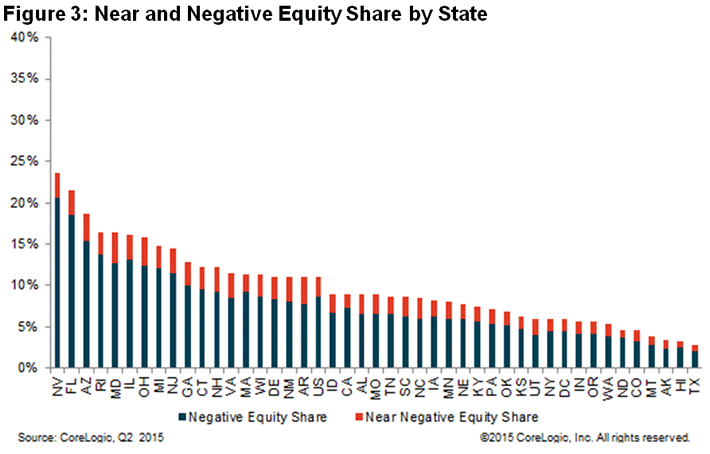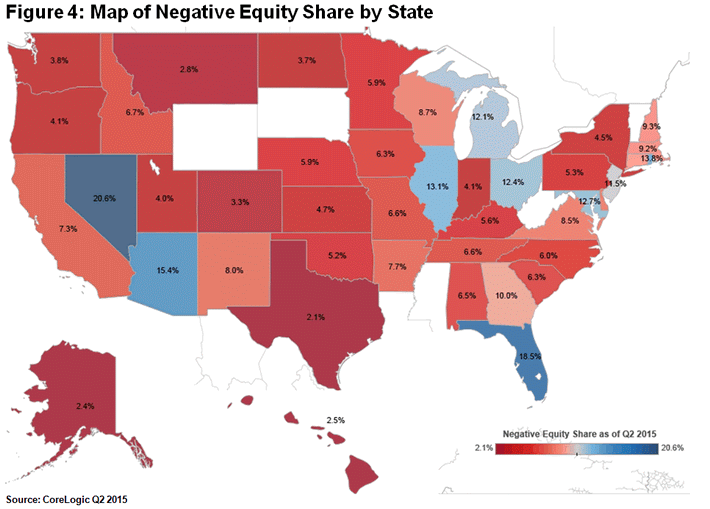Owners of more than three-quarters of a million U.S. homes regained equity in those homes during the second quarter of 2015. CoreLogic said on Tuesday that there are now approximately 45.9 million homes with positive equity, 91 percent of all mortgaged properties in the country.
The 759,000 properties that rose out of negative equity during the second quarter leaves approximately 4.4 million properties, 8.7 percent of all mortgage properties underwater, that is the outstanding mortgage balance exceeds the value of the home. There were 5.1 million homes or 10.2 percent or mortgaged properties underwater at the end of the second quarter of 2014.
The national aggregate value of negative equity was $309.5 billion at the end of Q2 2015, down approximately $28.5 billion from the total in the first quarter. Negative equity declined from $350 billion a year earlier, a decrease of 11.6 percent. Borrower equity overall increased by $691 billion in Quarter Two of 2015.
In addition to the 4.4 million properties in negative equity another 9 million or 17.8 percent, have less than 20 percent equity (referred to as "under-equitied"), and 1.1 million, or 2.3 percent, have less than 5 percent equity (referred to as near-negative equity). Borrowers who are "under-equitied" may have a more difficult time refinancing their existing homes or obtaining new financing to sell and buy another home due to underwriting constraints. Borrowers with near-negative equity are considered at risk of falling back into negative equity if home prices fall.

"Home price appreciation and foreclosure completions both reduce the number of homeowners with negative equity, the latter because most homeowners who lost homes through foreclosure had some level of negative equity," said Frank Nothaft, chief economist for CoreLogic. "Between June 2014 and June 2015, the CoreLogic national Home Price Index (HPI) rose 5.6 percent and we reported the number of homes completing foreclosure proceedings exceeded one-half million. Both of these factors helped reduce the number of homeowners with negative equity by one million over the year ending in June."
Nevada had the highest percentage of mortgaged residential properties in negative equity at 20.6 percent while Texas had the highest percentage in positive equity at 97.9 percent. Other states with high percentages of underwater borrowers were Florida (18.5 percent), Arizona (15.4 percent), Rhode Island (13.8 percent) and Illinois (13.1 percent). Those five states accounted for 31.7 percent of negative equity in the U.S. In addition to Texas, Alaska, Hawaii, Montana, and Colorado all had more than 96 percent of their mortgaged properties in positive territory.

Of the total $309 billion in negative equity, first liens without home equity loans, approximately 2.6 million properties, accounted for $168 billion, or 54 percent, of the aggregate negative equity. The average mortgage balance for this group of borrowers is $239,000 and the average underwater amount is $64,000.
The approximately 1.7 million underwater homeowners with both first and second liens accounted for $142 billion, or 46 percent of negative equity. The average mortgage balance for this group of borrowers is $303,000 and the average underwater amount is $82,000.
The bulk of positive equity for mortgaged properties is concentrated at the high end of the housing market. For example, 95 percent of homes valued at greater than $200,000 have equity, compared with 87 percent of homes valued at less than $200,000.
"For much of the country, the negative equity epidemic is lifting. The biggest reason for this improvement has been the relentless rise in home prices over the past three years which reflects increasing money flows into housing and a lack of housing stock in many markets," said Anand Nallathambi, president and CEO of CoreLogic. "CoreLogic predicts home prices to rise an additional 4.7 percent over the next year, and if this happens, 800,000 homeowners could regain positive equity by July 2016."







